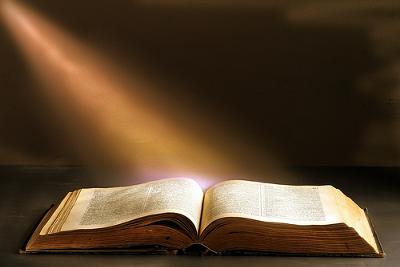Who Arrived at the Tomb First?
Our sermon yesterday (Nov 8, 2015) was in John 20:1-10, the first depiction of the Resurrection in John's gospel. John shows Mary Magdalene arriving at the tomb "early, while it was still dark."(Jn 20:1).
It's easy to get confused over the timeline of events in the New Testament, particularly when harmonizing (comparing) the four gospels to each other. One of the primary points of confusion occurs over how the Jews viewed the passing of a day. For them, the new day began at sundown, not sunup.
This places Mary Magdalene's visit to the tomb anytime during what we would consider to be Saturday evening or even very early Sunday morning. She went "while it was still dark." For the Jews, by the time it got dark on Saturday, it had become Sunday.
There have been many forests sacrificed trying to make all the pieces fit in the puzzle that appears when you read the gospels together. There are a number of excellent harmonies out there covering all four gospels. The problem they all
encounter is in how the gospels are written. They were written with a different (read Eastern) mindset, a very long time ago. This presents some difficulty when we read them with a modern, Western mindset. Trying to lay them out in the order a western mind demands is nearly impossible. In 1st century Palestinian writing, chronologies are sometimes ignored. The eastern mindset was for more concerned with getting the main points of the story told than getting all the events lined up.
So, is can be assumed that each of the gospels may have gaps that are not readily apparent, depending on what audience is being addressed and what lessons or truths are being conveyed. There may be times when things seem out of order compared to each other.
We do this all the time without really thinking about it. We'll say, "I didn't do much last night. I had dinner and went to bed." We may have had dinner at 6:00 PM and retired early at 9:00 PM. We assume the folks we are talking to realize we did not walk from the kitchen to the bedroom. Our real
message is, "Nothing of any consequence happened between 6 and 9." Anyone trying to reconstruct our evening based on what we said, or maybe wrote, would have a hard time knowing whether our language was literal or figurative, particularly if they are looking back on two millennia from now with a few different languages thrown into the mix just to keep things fun and interesting.
None of this makes one gospel wrong and the other right. None are more accurate than the others. Each of them is precise in the detail needed to tell its particular part of the story of the Resurrection. Piecing them together gives us a better look at it, but will not resolve all the mystery in trying to apprehend a supernatural, world-changing event.
Mystery, when it comes to God and how He functions, can be
a good thing, giving us a glimpse of His glory. It helps to keep in mind that those passages we don't easily comprehend are great ones to strive with, driving us deeper into the word and prayer, frequently showing us "things that are too wonderful to understand." (Job 42:3)
Here's a harmony I like. It has its struggles but they all do.It's one that allows for a few gaps that quite probably exist in each timeline.
As I mentioned, this timeline, as with most I've seen, has some flaws. If you have the time, it can be fascinating to take the various passages and piece together your own timeline.
While this can be an interesting exercise, none of the gospels were meant to tell the whole story on their own, just parts of it, the parts pertinent to their designated readers. They are not really meant to be harmonized. They are intended to give us different perspectives on the history-changing events surrounding Jesus Christ, His death and His resurrection. None of them are wrong. All of them were inspired through the minds and hearts of human beings, by the Holy Spirit.
 Ultimately, you don't have to struggle with this. It's not necessary for you to figure out every nuance and detail. Instead, allow it be a fascination, Let some of the mystery keep you in suspense. Marvel in the beauty that, for now, we see some things "in a mirror dimly" (1 Cor 13:12). The important thing to know is not who got to the tomb first, but that it was empty.
Ultimately, you don't have to struggle with this. It's not necessary for you to figure out every nuance and detail. Instead, allow it be a fascination, Let some of the mystery keep you in suspense. Marvel in the beauty that, for now, we see some things "in a mirror dimly" (1 Cor 13:12). The important thing to know is not who got to the tomb first, but that it was empty.
It's easy to get confused over the timeline of events in the New Testament, particularly when harmonizing (comparing) the four gospels to each other. One of the primary points of confusion occurs over how the Jews viewed the passing of a day. For them, the new day began at sundown, not sunup.
This places Mary Magdalene's visit to the tomb anytime during what we would consider to be Saturday evening or even very early Sunday morning. She went "while it was still dark." For the Jews, by the time it got dark on Saturday, it had become Sunday.
There have been many forests sacrificed trying to make all the pieces fit in the puzzle that appears when you read the gospels together. There are a number of excellent harmonies out there covering all four gospels. The problem they all
encounter is in how the gospels are written. They were written with a different (read Eastern) mindset, a very long time ago. This presents some difficulty when we read them with a modern, Western mindset. Trying to lay them out in the order a western mind demands is nearly impossible. In 1st century Palestinian writing, chronologies are sometimes ignored. The eastern mindset was for more concerned with getting the main points of the story told than getting all the events lined up.
So, is can be assumed that each of the gospels may have gaps that are not readily apparent, depending on what audience is being addressed and what lessons or truths are being conveyed. There may be times when things seem out of order compared to each other.
We do this all the time without really thinking about it. We'll say, "I didn't do much last night. I had dinner and went to bed." We may have had dinner at 6:00 PM and retired early at 9:00 PM. We assume the folks we are talking to realize we did not walk from the kitchen to the bedroom. Our real
message is, "Nothing of any consequence happened between 6 and 9." Anyone trying to reconstruct our evening based on what we said, or maybe wrote, would have a hard time knowing whether our language was literal or figurative, particularly if they are looking back on two millennia from now with a few different languages thrown into the mix just to keep things fun and interesting.
None of this makes one gospel wrong and the other right. None are more accurate than the others. Each of them is precise in the detail needed to tell its particular part of the story of the Resurrection. Piecing them together gives us a better look at it, but will not resolve all the mystery in trying to apprehend a supernatural, world-changing event.
Mystery, when it comes to God and how He functions, can be
a good thing, giving us a glimpse of His glory. It helps to keep in mind that those passages we don't easily comprehend are great ones to strive with, driving us deeper into the word and prayer, frequently showing us "things that are too wonderful to understand." (Job 42:3)
Here's a harmony I like. It has its struggles but they all do.It's one that allows for a few gaps that quite probably exist in each timeline.
As I mentioned, this timeline, as with most I've seen, has some flaws. If you have the time, it can be fascinating to take the various passages and piece together your own timeline.
While this can be an interesting exercise, none of the gospels were meant to tell the whole story on their own, just parts of it, the parts pertinent to their designated readers. They are not really meant to be harmonized. They are intended to give us different perspectives on the history-changing events surrounding Jesus Christ, His death and His resurrection. None of them are wrong. All of them were inspired through the minds and hearts of human beings, by the Holy Spirit.
 Ultimately, you don't have to struggle with this. It's not necessary for you to figure out every nuance and detail. Instead, allow it be a fascination, Let some of the mystery keep you in suspense. Marvel in the beauty that, for now, we see some things "in a mirror dimly" (1 Cor 13:12). The important thing to know is not who got to the tomb first, but that it was empty.
Ultimately, you don't have to struggle with this. It's not necessary for you to figure out every nuance and detail. Instead, allow it be a fascination, Let some of the mystery keep you in suspense. Marvel in the beauty that, for now, we see some things "in a mirror dimly" (1 Cor 13:12). The important thing to know is not who got to the tomb first, but that it was empty.



















No comments:
Post a Comment